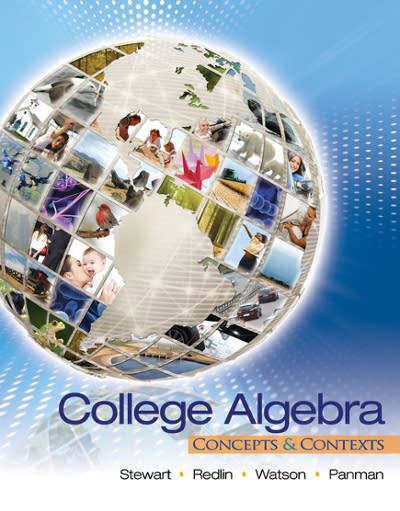Question
1, Richard has just been given a4-question multiple-choice quiz in his history class. Each question has five answers, of which only one is correct. Since
1, Richard has just been given a4-question multiple-choice quiz in his history class. Each question has five answers, of which only one is correct. Since Richard has not attended class recently, he doesn't know any of the answers. Assuming that Richard guesses on allfourquestions, find the indicated probabilities. (Round your answers to three decimal places.)
(a)What is the probability that he will answer all questions correctly?
(b)What is the probability that he will answer all questions incorrectly?(
c)What is the probability that he will answer at least one of the questions correctly? Compute this probability two ways. First, use the rule for mutually exclusive events and the probabilities shown in thebinomial probability distribution table.
d)Then use the fact thatP(r1) = 1P(r= 0).
e) Compare the two results. Should they be equal? Are they equal? If not, how do you account for the difference?
1. They should not be equal, but are equal.
2. They should be equal, but may differ slightly due to rounding error.
3. They should be equal, but may not be due to table error.
4. They should be equal, but differ substantially.
(f)What is the probability that Richard will answer at least half the questions correctly?
2. Sociologists say that95%of married women claim that their husband's mother is the biggest bone of contention in their marriages (sex and money are lower-rated areas of contention). Suppose thatninemarried women are having coffee together one morning. Find the following probabilities. (Round your answers to three decimal places.)(a) All of them dislike their mother-in-law. (b) None of them dislike their mother-in-law. (c) At leastsevenof them dislike their mother-in-law. (d) No more thansixof them dislike their mother-in-law.
3. A research team conducted a study showing that approximately15%of all businessmen who wear ties wear them so tightly that they actually reduce blood flow to the brain, diminishing cerebral functions. At a board meeting of15businessmen, all of whom wear ties, what are the following probabilities? (Round your answers to three decimal places.)(a) at least one tie is too tight (b) more than two ties are too tight (c) no tie is too tight (d) at least13ties arenottoo tight
4. USA Todayreported that about 20% of all people in the United States are illiterate. Suppose you takeelevenpeople at random off a city street.(a) Make a histogram showing the probability distribution of the number of illiterate people out of theelevenpeople in the sample.
(b) Find the mean and standard deviation of this probability distribution. (Round your standard deviation to two decimal places.)
| = people |
| = people |
Find the expected number of people in this sample who are illiterate. people (c) How many people would you need to interview to be97%sure that at least seven of these people can read and write (are not illiterate)? (Enter the smallest number of people needed to be at least97%sure.) people
5. Use the geometric probability distribution to solve the following problem.
On the leeward side of the island of Oahu, in a small village, about 78% of the residents are of Hawaiian ancestry. Let n = 1, 2, 3, ... represent the number of people you must meet until you encounter the first person of Hawaiian ancestry in the village.
(a)Write out a formula for the probability distribution of the random variable n.P(n) =
(b)Compute the probabilities that n = 1, n = 2, and n = 3. (Round your answers to three decimal places.)
P(1)=
P(2)=
P(3)=
(c)Compute the probability that n 4.
Hint: P(n 4) = 1 P(n = 1) P(n = 2) P(n = 3).(Round your answer to three decimal places.)
(d)In a more urban part of Oahu, it is estimated that about 8% of the residents are of Hawaiian ancestry. Repeat parts (a), (b), and (c) for this part of the island.
(i)Write out a formula for the probability distribution of the random variable n.
P(n) =
(ii)Compute the probabilities that n = 1, n = 2, and n = 3. (Round your answers to three decimal places.)
P(1)=
P(2)=
P(3)=
(iii)Compute the probability that n 4.
Hint: P(n 4) = 1 P(n = 1) P(n = 2) P(n = 3).(Round your answer to three decimal places.)
Step by Step Solution
There are 3 Steps involved in it
Step: 1

Get Instant Access to Expert-Tailored Solutions
See step-by-step solutions with expert insights and AI powered tools for academic success
Step: 2

Step: 3

Ace Your Homework with AI
Get the answers you need in no time with our AI-driven, step-by-step assistance
Get Started


